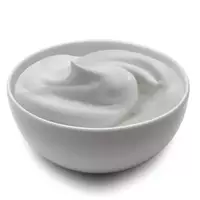Cream juice

Crème fraîche is nothing more than France's famous national fermented milk product, which differs from others in its specific fat content. As a rule, the fat content of creme fresco does not exceed 30%. In its appearance and consistency, creme fraiche resembles sour cream or yogurt. Crème fraîche is made on the basis of high-quality cow's milk.
Creme fraiche takes its original name from the phrase crème fraîche, which literally translates from French as "fresh cream. " Creme fraiche has a pleasant and tender, slightly acidic taste. It is worth noting that creme fraiche is practically indistinguishable from sour cream not only in appearance, but also in production technology.
It is noteworthy that there are no dietary supplements in the composition of a real French cream fresco. There are several main varieties of creme fresco that differ from each other in their fat content, and besides, their taste. Most often on sale you can find creme fresco 15, 18 and 28% fat content. In addition, creme fraiche with the addition of sucrose, garlic, gelatin or herbs is especially popular.
In cooking, creme fraiche is used as a component ingredient of the first courses, as well as sauces. Some of the famous sauces of the national cuisine of France are made on the basis of cream freshes of various greasiness. In addition, crème fraîche is considered a good marinade for meat and poultry. At the initial stage of production, cream fresco is made from whole cow's milk, which is then placed in a large container.
At the next stage, milk bacteria are added to the cream, which help to form the taste of the finished sour-milk product. It is worth noting that cream is left for 18-20 hours at a temperature of 20 to 40S to start natural processes in which dairy bacteria begin to produce milk sugar, and in addition lactic acid.
It is distinctive that it is thanks to the chemical process of denaturation of milk proteins in cream that crème fraîche acquires its distinctive taste, as well as useful and consumer characteristics. The chemical composition of creme fresco is subject to certain requirements that do not allow the use of preservatives, stabilizers or other food additives in the composition of the fermented milk product.
In addition, after the fermentation process, creme fraiche, unlike other fermented milk products, does not undergo additional temperature treatment. This allows preserving the unique vitamin-mineral composition of the product, which is enriched with a sufficient amount of natural compounds useful for the human body. Creme fraiche is considered its national fermented milk product not only in France but also in Belgium, and in addition in a number of other European countries.
It is worth noting that creme fraiche and sour cream are still giving independent food. Moreover, creme fraiche, unlike sour cream, does not separate into fractions when heated. For this reason, cream fresh in the recipe of French cuisine can be replaced with sour cream only if the culinary product is not subjected to thermal treatment during the preparation process.
fresco cream 249 kCal
The energy value of fresh cream (Ratio of proteins, fats, carbohydrates - ju):
Proteins: 2.3 g (~ 9 kCal)
Fats: 25.5 g (~ 230 kCal)
Carbohydrates: 3.3 g (~ 13 kCal)
Energy ratio (bj | y): 4% | 92% | 5%
 Español
Español Français
Français Português
Português Русский
Русский 简体中文
简体中文 繁體中文
繁體中文 日本語
日本語 한국어
한국어 العربية
العربية Türkçe
Türkçe Қазақ
Қазақ Deutsch
Deutsch Italiano
Italiano Українська
Українська
